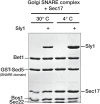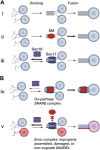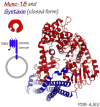SM proteins Sly1 and Vps33 co-assemble with Sec17 and SNARE complexes to oppose SNARE disassembly by Sec18
- PMID: 24837546
- PMCID: PMC4060006
- DOI: 10.7554/eLife.02272
SM proteins Sly1 and Vps33 co-assemble with Sec17 and SNARE complexes to oppose SNARE disassembly by Sec18
Abstract
Secretory and endolysosomal fusion events are driven by SNAREs and cofactors, including Sec17/α-SNAP, Sec18/NSF, and Sec1/Munc18 (SM) proteins. SMs are essential for fusion in vivo, but the basis of this requirement is enigmatic. We now report that, in addition to their established roles as fusion accelerators, SM proteins Sly1 and Vps33 directly shield SNARE complexes from Sec17- and Sec18-mediated disassembly. In vivo, wild-type Sly1 and Vps33 function are required to withstand overproduction of Sec17. In vitro, Sly1 and Vps33 impede SNARE complex disassembly by Sec18 and ATP. Unexpectedly, Sec17 directly promotes selective loading of Sly1 and Vps33 onto cognate SNARE complexes. A large thermodynamic barrier limits SM binding, implying that significant conformational rearrangements are involved. In a working model, Sec17 and SMs accelerate fusion mediated by cognate SNARE complexes and protect them from NSF-mediated disassembly, while mis-assembled or non-cognate SNARE complexes are eliminated through kinetic proofreading by Sec18.DOI: http://dx.doi.org/10.7554/eLife.02272.001.
Keywords: Golgi; HOPS; SNARE; docking; lysosome; membrane.
Copyright © 2014, Lobingier et al.
Conflict of interest statement
The authors declare that no competing interests exist.
Figures
















Comment in
-
To protect or reject.Elife. 2014 Jun 17;3:e03374. doi: 10.7554/eLife.03374. Elife. 2014. PMID: 24940001 Free PMC article.
Similar articles
-
Sec17 (α-SNAP) and Sec18 (NSF) restrict membrane fusion to R-SNAREs, Q-SNAREs, and SM proteins from identical compartments.Proc Natl Acad Sci U S A. 2019 Nov 19;116(47):23573-23581. doi: 10.1073/pnas.1913985116. Epub 2019 Nov 4. Proc Natl Acad Sci U S A. 2019. PMID: 31685636 Free PMC article.
-
Sec17 (α-SNAP) and an SM-tethering complex regulate the outcome of SNARE zippering in vitro and in vivo.Elife. 2017 Sep 19;6:e27396. doi: 10.7554/eLife.27396. Elife. 2017. PMID: 28925353 Free PMC article.
-
Sec17 can trigger fusion of trans-SNARE paired membranes without Sec18.Proc Natl Acad Sci U S A. 2015 May 5;112(18):E2290-7. doi: 10.1073/pnas.1506409112. Epub 2015 Apr 20. Proc Natl Acad Sci U S A. 2015. PMID: 25902545 Free PMC article.
-
Decoding the interactions of SM proteins with SNAREs.ScientificWorldJournal. 2005 Jun 8;5:471-7. doi: 10.1100/tsw.2005.53. ScientificWorldJournal. 2005. PMID: 15962202 Free PMC article. Review.
-
At the junction of SNARE and SM protein function.Curr Opin Cell Biol. 2010 Aug;22(4):488-95. doi: 10.1016/j.ceb.2010.04.006. Epub 2010 May 12. Curr Opin Cell Biol. 2010. PMID: 20471239 Free PMC article. Review.
Cited by
-
α-SNAP Enhances SNARE Zippering by Stabilizing the SNARE Four-Helix Bundle.Cell Rep. 2016 Apr 19;15(3):531-539. doi: 10.1016/j.celrep.2016.03.050. Epub 2016 Apr 7. Cell Rep. 2016. PMID: 27068468 Free PMC article.
-
ARC Syndrome-Linked Vps33B Protein Is Required for Inflammatory Endosomal Maturation and Signal Termination.Immunity. 2016 Aug 16;45(2):267-79. doi: 10.1016/j.immuni.2016.07.010. Epub 2016 Aug 2. Immunity. 2016. PMID: 27496733 Free PMC article.
-
Munc18a does not alter fusion rates mediated by neuronal SNAREs, synaptotagmin, and complexin.J Biol Chem. 2015 Apr 17;290(16):10518-34. doi: 10.1074/jbc.M114.630772. Epub 2015 Feb 25. J Biol Chem. 2015. PMID: 25716318 Free PMC article.
-
Stx5-Mediated ER-Golgi Transport in Mammals and Yeast.Cells. 2019 Jul 26;8(8):780. doi: 10.3390/cells8080780. Cells. 2019. PMID: 31357511 Free PMC article. Review.
-
The Participation of Regulatory Lipids in Vacuole Homotypic Fusion.Trends Biochem Sci. 2019 Jun;44(6):546-554. doi: 10.1016/j.tibs.2018.12.003. Epub 2018 Dec 23. Trends Biochem Sci. 2019. PMID: 30587414 Free PMC article. Review.
References
Publication types
MeSH terms
Substances
Grants and funding
LinkOut - more resources
Full Text Sources
Other Literature Sources
Molecular Biology Databases

